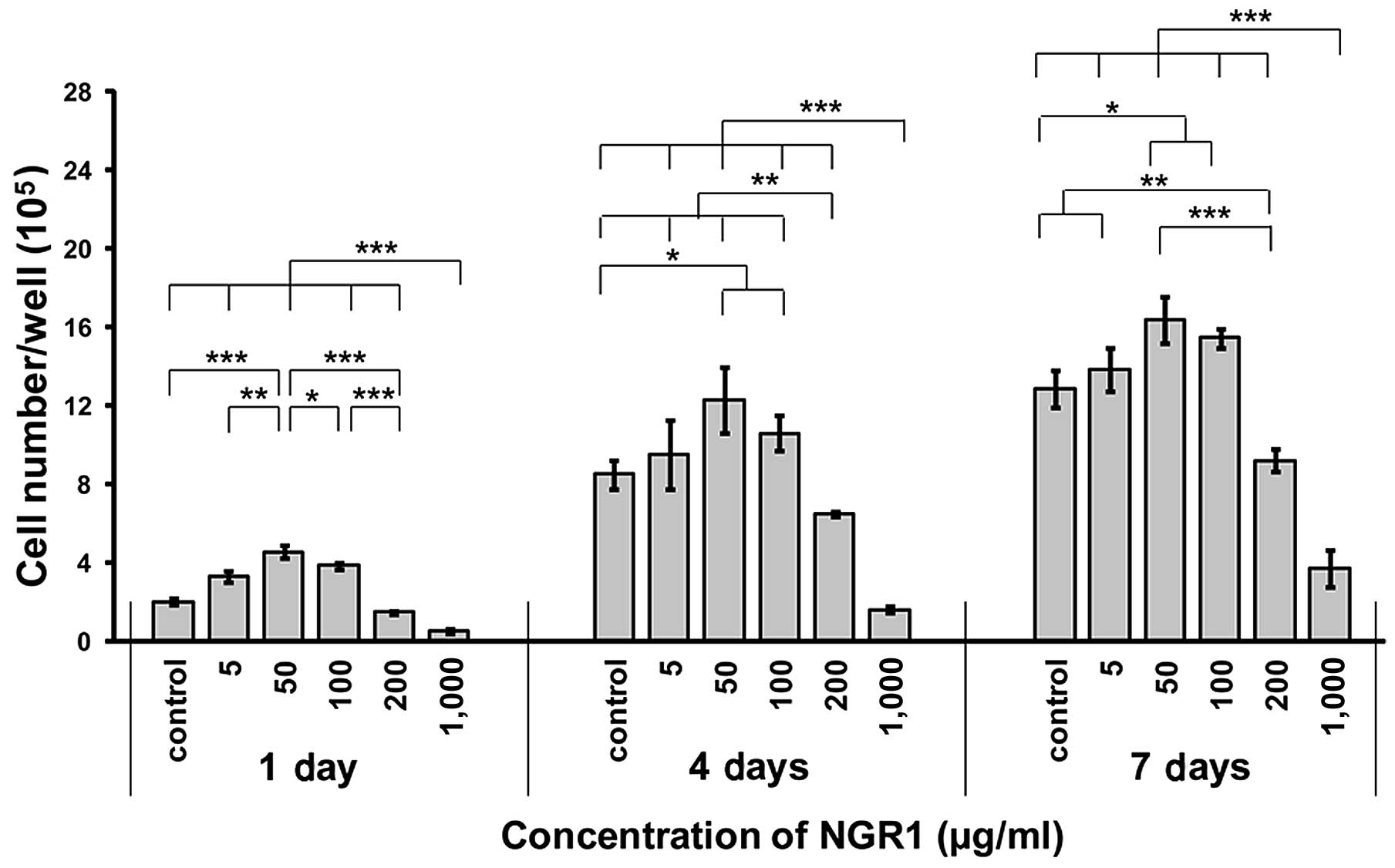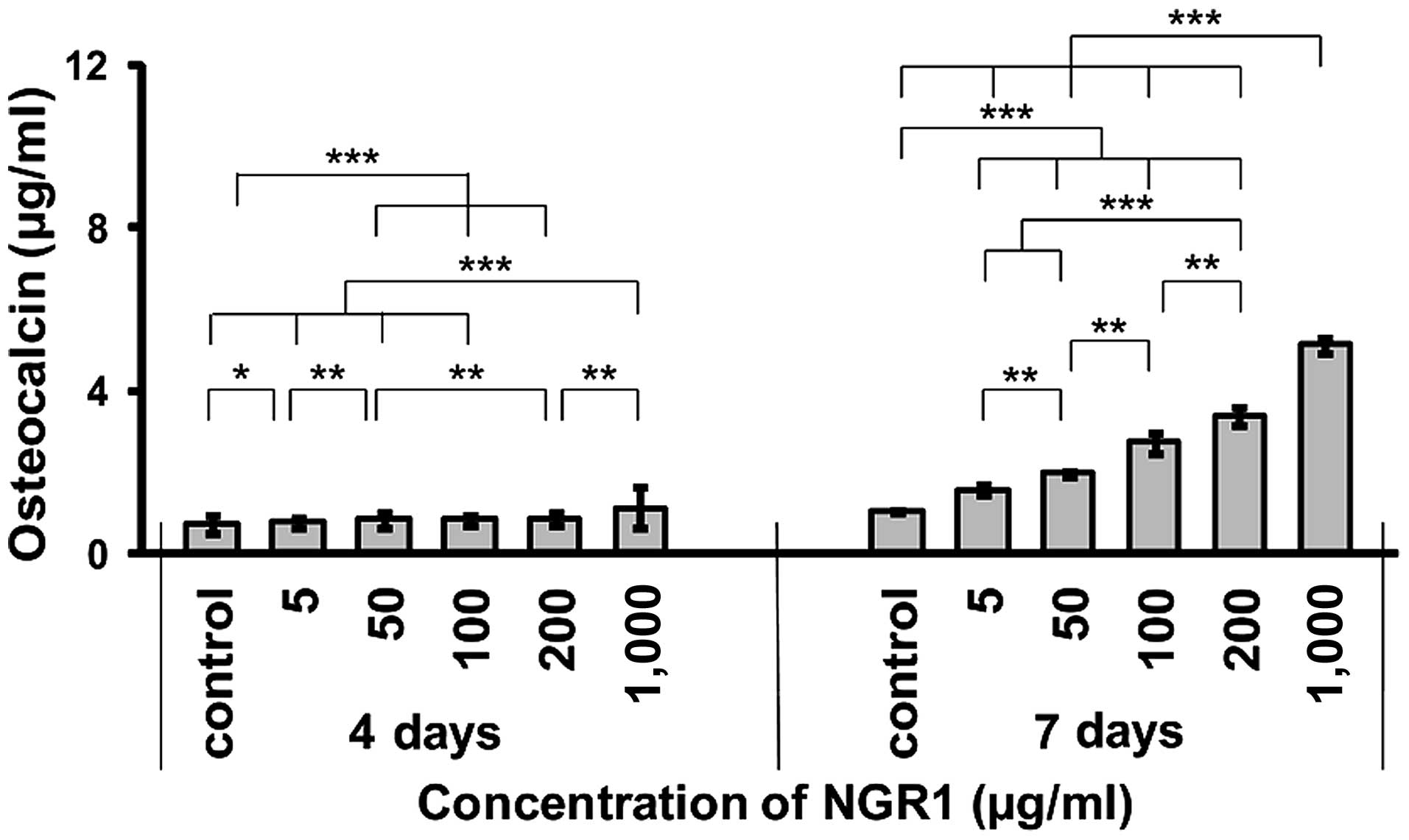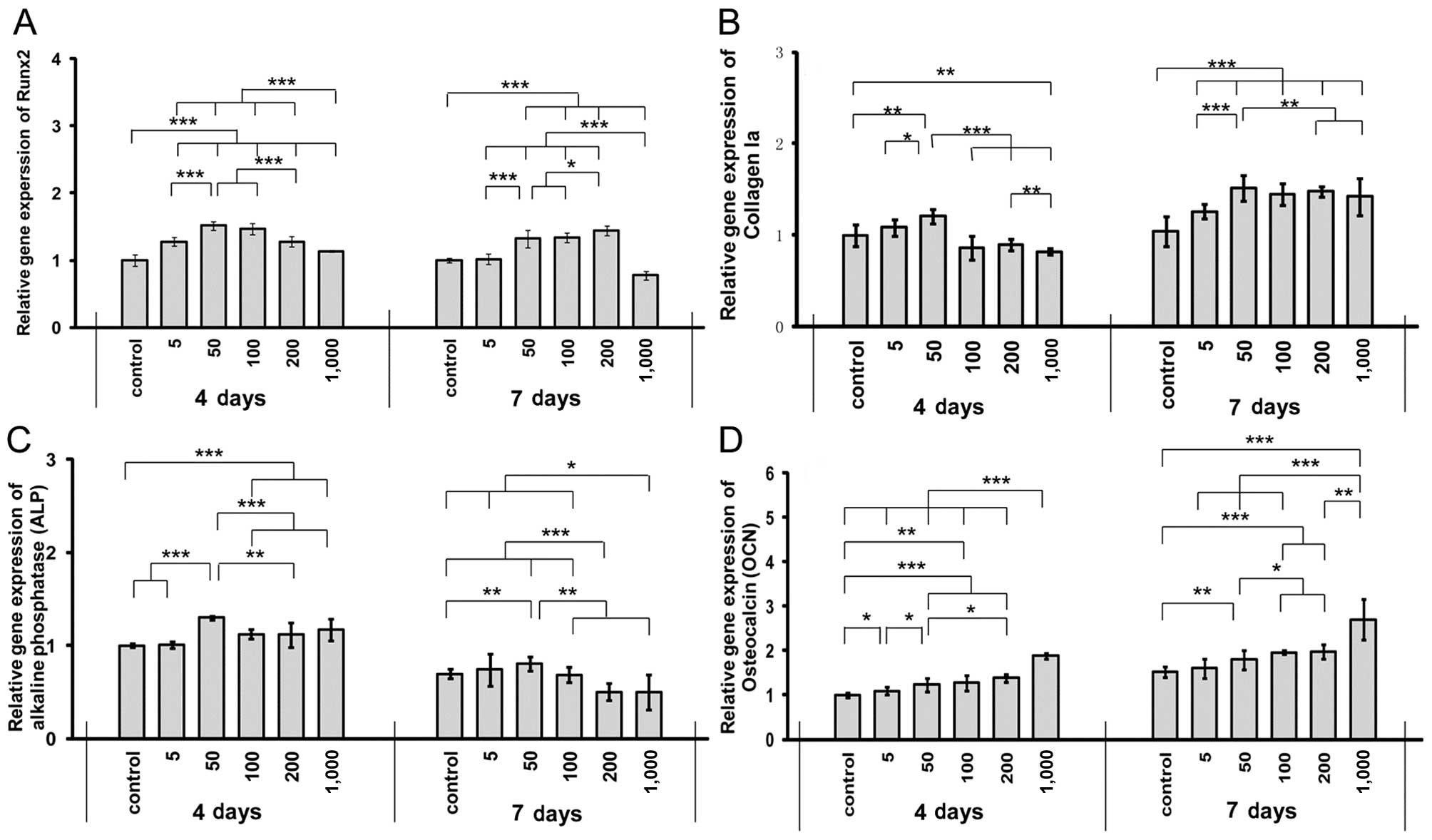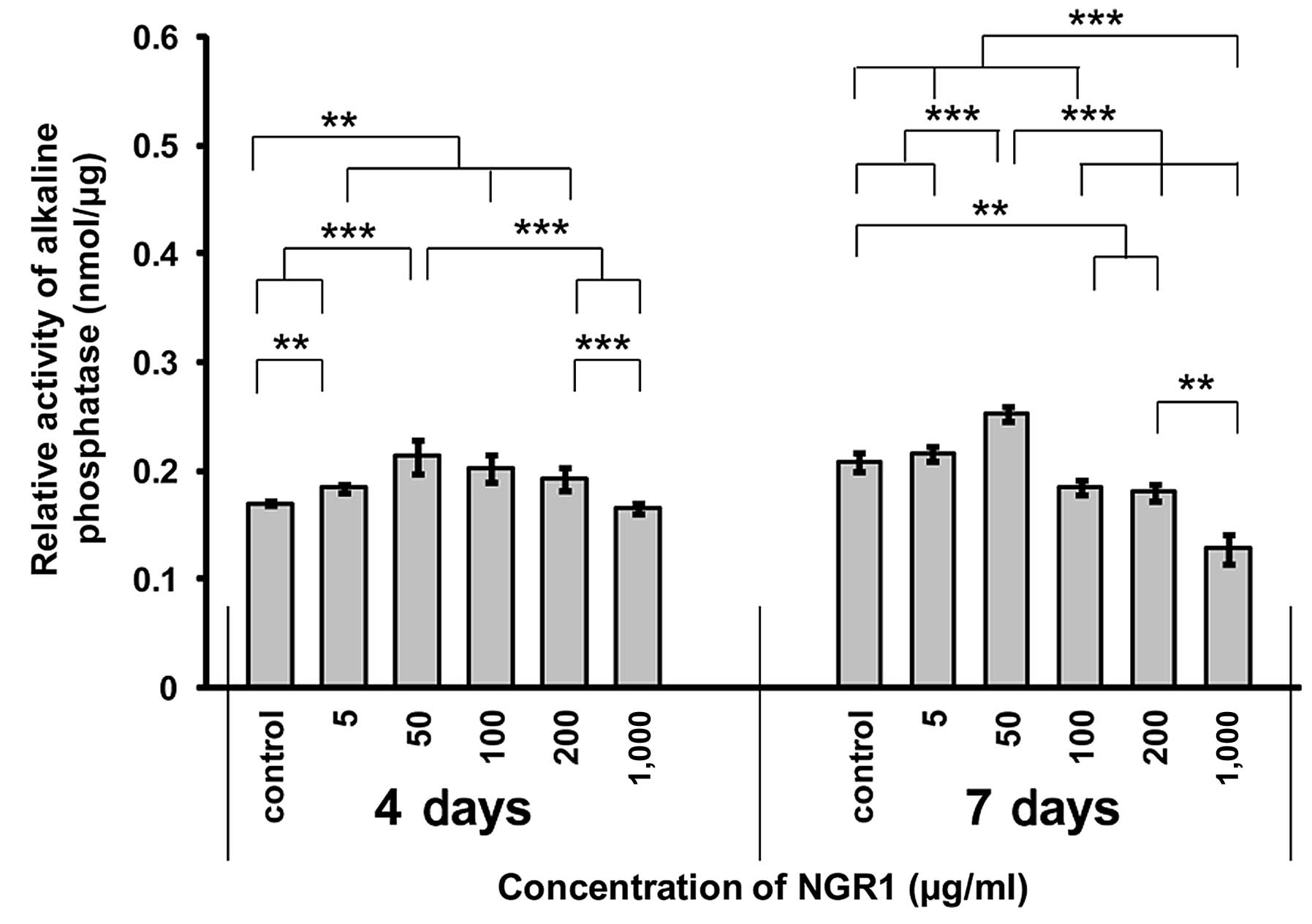|
1
|
Bi W, Gu Z, Zheng Y, Zhang X, Guo J and Wu
G: Heterodimeric BMP-2/7 antagonizes the inhibition of all-trans
retinoic acid and promotes the osteoblastogenesis. PLoS One.
8:e781982013. View Article : Google Scholar : PubMed/NCBI
|
|
2
|
Zimmermann G and Moghaddam A: Allograft
bone matrix versus synthetic bone graft substitutes. Injury.
42(Suppl 2): S16–S21. 2011. View Article : Google Scholar : PubMed/NCBI
|
|
3
|
Shadjou N and Hasanzadeh M: Silica-based
mesoporous nano-biomaterials as promoter of bone regeneration
process. J Biomed Mater Res A. 103:3703–3716. 2015. View Article : Google Scholar : PubMed/NCBI
|
|
4
|
Zheng Y, Wu G, Zhao J, Wang L, Sun P and
Gu Z: rhBMP2/7 heterodimer: An osteoblastogenesis inducer of not
higher potency but lower effective concentration compared with
rhBMP2 and rhBMP7 homodimers. Tissue Eng Part A. 16:879–887. 2010.
View Article : Google Scholar
|
|
5
|
Govender S, Csimma C, Genant HK,
Valentin-Opran A, Amit Y, Arbel R, Aro H, Atar D, Bishay M, Börner
MG, et al: Recombinant human bone morphogenetic protein-2 for
treatment of open tibial fractures: a prospective, controlled,
randomized study of four hundred and fifty patients. J Bone Joint
Surg Am. 84-A:2123–2134. 2002.PubMed/NCBI
|
|
6
|
Boden SD, Kang J, Sandhu H and Heller JG:
Use of recombinant human bone morphogenetic protein-2 to achieve
posterolateral lumbar spine fusion in humans: a prospective,
randomized clinical pilot trial: 2002 Volvo Award in clinical
studies. Spine. 27:2662–2673. 2002. View Article : Google Scholar : PubMed/NCBI
|
|
7
|
Kaneko H, Arakawa T, Mano H, Kaneda T,
Ogasawara A, Nakagawa M, Toyama Y, Yabe Y, Kumegawa M and Hakeda Y:
Direct stimulation of osteoclastic bone resorption by bone
morphogenetic protein (BMP)-2 and expression of BMP receptors in
mature osteoclasts. Bone. 27:479–486. 2000. View Article : Google Scholar : PubMed/NCBI
|
|
8
|
Uludag H, D'Augusta D, Palmer R, Timony G
and Wozney J: Characterization of rhBMP-2 pharmacokinetics
implanted with biomaterial carriers in the rat ectopic model. J
Biomed Mater Res. 46:193–202. 1999. View Article : Google Scholar : PubMed/NCBI
|
|
9
|
Sokolsky-Papkov M, Agashi K, Olaye A,
Shakesheff K and Domb AJ: Polymer carriers for drug delivery in
tissue engineering. Adv Drug Deliv Rev. 59:187–206. 2007.
View Article : Google Scholar : PubMed/NCBI
|
|
10
|
Carson JS and Bostrom MP: Synthetic bone
scaffolds and fracture repair. Injury. 38(Suppl 1): S33–S37. 2007.
View Article : Google Scholar : PubMed/NCBI
|
|
11
|
Kessler P, Thorwarth M, Bloch-Birkholz A,
Nkenke E and Neukam FW: Harvesting of bone from the iliac crest -
comparison of the anterior and posterior sites. Br J Oral
Maxillofac Surg. 43:51–56. 2005. View Article : Google Scholar
|
|
12
|
Yang X, Xiong X, Wang H and Wang J:
Protective effects of Panax notoginseng saponins on cardiovascular
diseases: a comprehensive overview of experimental studies. Evid
Based Complement Alternat Med. 2014:2048402014. View Article : Google Scholar : PubMed/NCBI
|
|
13
|
Qiang H, Zhang C, Shi ZB, Yang HQ and Wang
KZ: Protective effects and mechanism of Panax notoginseng saponins
on oxidative stress-induced damage and apoptosis of rabbit bone
marrow stromal cells. Chin J Integr Med. 16:525–530. 2010.
View Article : Google Scholar : PubMed/NCBI
|
|
14
|
Li XD, Liu ZY, Chang B, Liu DX, Chen B,
Guo C, Wang YG, Xu JK, Huang DY and Du SX: Panax notoginseng
saponins promote osteogenic differentiation of bone marrow stromal
cells through the ERK and P38 MAPK signaling pathways. Cell Physiol
Biochem. 28:367–376. 2011. View Article : Google Scholar : PubMed/NCBI
|
|
15
|
Yin LM, Wang X, Qian XD, Lin XJ, Chen XH
and Gao RL: Effects of Panax notoginseng saponins on proliferation
and differentiation in NIH3T3 cells. Chin J Integr Med. 18:616–620.
2012. View Article : Google Scholar : PubMed/NCBI
|
|
16
|
Li XD, Chang B, Chen B, Liu ZY, Liu DX,
Wang JS, Hou GQ, Huang DY and Du SX: Panax notoginseng saponins
potentiate osteogenesis of bone marrow stromal cells by modulating
gap junction intercellular communication activities. Cell Physiol
Biochem. 26:1081–1092. 2010. View Article : Google Scholar
|
|
17
|
Li XD, Wang JS, Chang B, Chen B, Guo C,
Hou GQ, Huang DY and Du SX: Panax notoginseng saponins promotes
proliferation and osteogenic differentiation of rat bone marrow
stromal cells. J Ethnopharmacol. 134:268–274. 2011. View Article : Google Scholar
|
|
18
|
Jia C, Xiong M, Wang P, Cui J, Du X, Yang
Q, Wang W, Chen Y and Zhang T: Notoginsenoside R1 attenuates
atherosclerotic lesions in ApoE deficient mouse model. PLoS One.
9:e998492014. View Article : Google Scholar : PubMed/NCBI
|
|
19
|
Yu HS, Zhang LJ, Song XB, Liu YX, Zhang J,
Cao M, Kang LP, Kang TG and Ma BP: Chemical constituents from
processed rhizomes of Panax notoginseng. Zhongguo Zhong Yao Za Zhi.
38:3910–3917. 2013.In Chinese.
|
|
20
|
Horii A, Wang X, Gelain F and Zhang S:
Biological designer self-assembling peptide nanofiber scaffolds
significantly enhance osteoblast proliferation, differentiation and
3-D migration. PLoS One. 2:e1902007. View Article : Google Scholar : PubMed/NCBI
|
|
21
|
Fatokun AA, Stone TW and Smith RA:
Hydrogen peroxide- induced oxidative stress in MC3T3-E1 cells: The
effects of glutamate and protection by purines. Bone. 39:542–551.
2006. View Article : Google Scholar : PubMed/NCBI
|
|
22
|
Iwata T, Morotome Y, Tanabe T, Fukae M,
Ishikawa I and Oida S: Noggin blocks osteoinductive activity of
porcine enamel extracts. J Dent Res. 81:387–391. 2002. View Article : Google Scholar : PubMed/NCBI
|
|
23
|
Kuske B, Savkovic V and zur Nieden NI:
Improved media compositions for the differentiation of embryonic
stem cells into osteoblasts and chondrocytes. Methods Mol Biol.
690:195–215. 2011. View Article : Google Scholar
|
|
24
|
Galindo M, Pratap J, Young DW,
Hovhannisyan H, Im HJ, Choi JY, Lian JB, Stein JL, Stein GS and van
Wijnen AJ: The bone-specific expression of Runx2 oscillates during
the cell cycle to support a G1-related antiproliferative function
in osteoblasts. J Biol Chem. 280:20274–20285. 2005. View Article : Google Scholar : PubMed/NCBI
|
|
25
|
Pratap J, Galindo M, Zaidi SK, Vradii D,
Bhat BM, Robinson JA, Choi JY, Komori T, Stein JL, Lian JB, et al:
Cell growth regulatory role of Runx2 during proliferative expansion
of preosteoblasts. Cancer Res. 63:5357–5362. 2003.PubMed/NCBI
|
|
26
|
Kang X, Li Z, Zhang WH, Zhou Q, Liu RH and
Wang XJ: Study on effect of combination of Epimedii Folium and
Ligustri Lucidi Fructus on osteoporosis rats induced by retinoic
acid. Zhongguo Zhong Yao Za Zhi. 38:4124–4128. 2013.In Chinese.
|
|
27
|
Wang X, Zhen L, Zhang G, Wong MS, Qin L
and Yao X: Osteogenic effects of flavonoid aglycones from an
osteoprotective fraction of Drynaria fortunei - an in vitro
efficacy study. Phytomedicine. 18:868–872. 2011. View Article : Google Scholar : PubMed/NCBI
|
|
28
|
Ma HP, Ming LG, Ge BF, Zhai YK, Song P,
Xian CJ and Chen KM: Icariin is more potent than genistein in
promoting osteoblast differentiation and mineralization in vitro. J
Cell Biochem. 112:916–923. 2011. View Article : Google Scholar : PubMed/NCBI
|
|
29
|
Tsuji-Naito K: Aldehydic components of
cinnamon bark extract suppresses RANKL-induced osteoclastogenesis
through NFATc1 downregulation. Bioorg Med Chem. 16:9176–9183. 2008.
View Article : Google Scholar : PubMed/NCBI
|
|
30
|
Gong W and Li F: Quality evaluation on
different specifications of Cervi Cornu Pantotrichum with its
effect on ovariectomized osteoporosis model rats. Zhongguo Zhong
Yao Za Zhi. 39:2326–2329. 2014.In Chinese. PubMed/NCBI
|
|
31
|
Zhong L, Zhou XL, Liu YS, Wang YM, Ma F,
Guo BL, Yan ZQ and Zhang QY: Estrogen receptor α mediates the
effects of notoginsenoside R1 on endotoxin-induced inflammatory and
apoptotic responses in H9c2 cardiomyocytes. Mol Med Rep.
12:119–126. 2015.PubMed/NCBI
|
|
32
|
Shi X, Yu W, Yang T, Liu W, Zhao Y, Sun Y,
Chai L, Gao Y, Dong Bin and Zhu L: Panax notoginseng saponins
provide neuroprotection by regulating NgR1/RhoA/Rock2 pathway
expression, in vitro and in vivo. J Ethnopharmacol. June
8–2016.Epub ahead of print. View Article : Google Scholar
|
|
33
|
Wang P, Cui J, Du X, Yang Q, Jia C, Xiong
M, Yu X, Li L, Wang W, Chen Y and Zhang T: Panax notoginseng
saponins (PNS) inhibits breast cancer metastasis. J Ethnopharmacol.
154:663–671. 2014. View Article : Google Scholar : PubMed/NCBI
|
|
34
|
Yang BR, Cheung KK, Zhou X, Xie RF, Cheng
PP, Wu S, Zhou ZY, Tang JY, Hoi PM, Wang YH and Lee SM:
Amelioration of acute myocardial infarction by saponins from flower
buds of Panax notoginseng via pro-angiogenesis and anti-apoptosis.
J Ethnopharmacol. 181:50–58. 2016. View Article : Google Scholar : PubMed/NCBI
|
|
35
|
Wang T, Guo R, Zhou G, Zhou X, Kou Z, Sui
F, Li C, Tang L and Wang Z: Traditional uses, botany,
phytochemistry, pharmacology and toxicology of Panax notoginseng
(Burk.) F.H. Chen: A review. J Ethnopharmacol. May 3–2016.Epub
ahead of print. View Article : Google Scholar
|
|
36
|
Wang X, Jiang L, Wang X, Yin F, Li G, Feng
X, Wang K and Sun S: Combination of autologous transplantation of
G-CSF-mobilized peripheral blood mononuclear cells and Panax
notoginseng saponins in the treatment of unreconstructable critical
limb ischemia. Ann Vasc Surg. 28:1501–1512. 2014. View Article : Google Scholar : PubMed/NCBI
|
|
37
|
Lee BA, Lee HS, Jung YS, Kim SW, Lee YW,
Chang SH, Chung HJ, Kim OS and Kim YJ: The effects of a novel
botanical agent on lipopolysaccharide-induced alveolar bone loss in
rats. J Periodontol. 84:1221–1229. 2013. View Article : Google Scholar
|
|
38
|
Chen B, Li XD, Liu DX, Wang H, Xie P, Liu
ZY, Hou GQ, Chang B and Du SX: Canonical Wnt signaling is required
for Panax notoginseng saponin-mediated attenuation of the RANKL/OPG
ratio in bone marrow stromal cells during osteogenic
differentiation. Phytomedicine. 19:1029–1034. 2012. View Article : Google Scholar : PubMed/NCBI
|
|
39
|
Chen W, Dang Y and Zhu C: Simultaneous
determination of three major bioactive saponins of Panax
notoginseng using liquid chromatography-tandem mass spectrometry
and a pharmacokinetic study. Chin Med. 5:122010. View Article : Google Scholar : PubMed/NCBI
|
|
40
|
Sun Q, Meng QT, Jiang Y, Liu HM, Lei SQ,
Su WT, Duan WN, Wu Y and Xia ZY and Xia ZY: Protective effect of
ginsenoside Rb1 against intestinal ischemia-reperfusion induced
acute renal injury in mice. PLoS One. 8:e808592013. View Article : Google Scholar : PubMed/NCBI
|
|
41
|
Song ZJ, Tang LL and Li GL: The protective
function and mechanism of notoginsenoside Rb1 against hypoxia
hypercapnia-induced pulmonary vasoconstriction. Zhongguo Zhong Xi
Yi Jie He Za Zhi. 32:1380–1384. 2012.In Chinese. PubMed/NCBI
|
|
42
|
Shen Y, Li YQ, Li SP, Ma L, Ding LJ and Ji
H: Alleviation of ovariectomy-induced osteoporosis in rats by Panax
notoginseng saponins. J Nat Med. 64:336–345. 2010. View Article : Google Scholar : PubMed/NCBI
|
|
43
|
Logan DC: Bacteriological standards in the
investigation of enteric convalescents. BMJ. 1:222–223. 1942.
View Article : Google Scholar : PubMed/NCBI
|
|
44
|
Sasano Y, Li HC, Zhu JX, Imanaka-Yoshida
K, Mizoguchi I and Kagayama M: Immunohistochemical localization of
type I collagen, fibronectin and tenascin C during embryonic
osteogenesis in the dentary of mandibles and tibias in rats.
Histochem J. 32:591–598. 2000. View Article : Google Scholar
|
|
45
|
Son JH, Cho YC, Sung IY, Kim IR, Park BS
and Kim YD: Melatonin promotes osteoblast differentiation and
mineralization of MC3T3-E1 cells under hypoxic conditions through
activation of PKD/p38 pathways. J Pineal Res. 57:385–392. 2014.
View Article : Google Scholar : PubMed/NCBI
|
|
46
|
Okamura H, Yoshida K, Yang D and Haneji T:
Protein phosphatase 2A Cα regulates osteoblast differentiation and
the expressions of bone sialoprotein and osteocalcin via osterix
transcription factor. J Cell Physiol. 228:1031–1037. 2013.
View Article : Google Scholar
|














